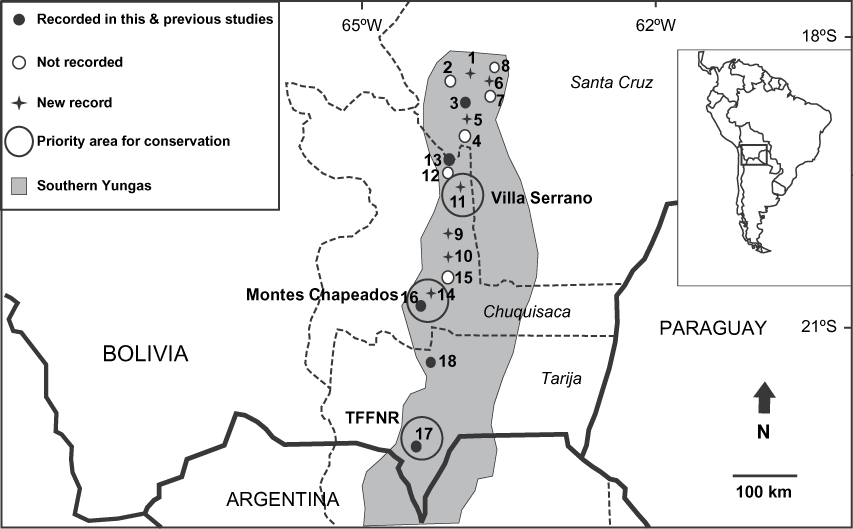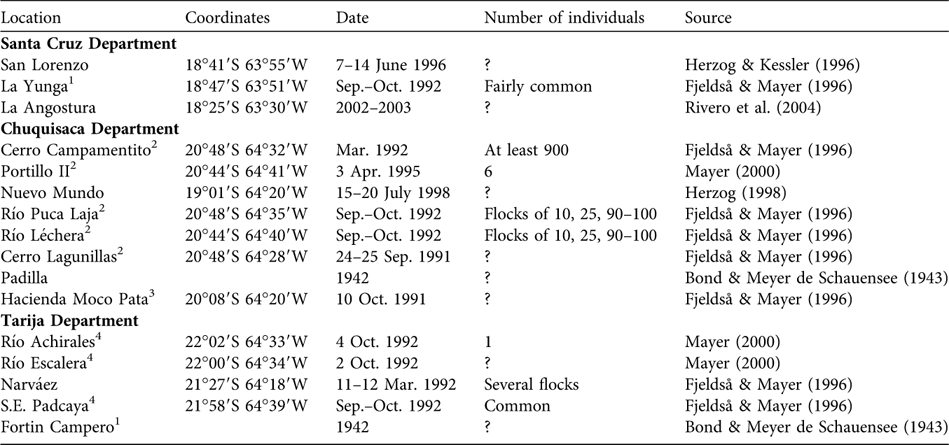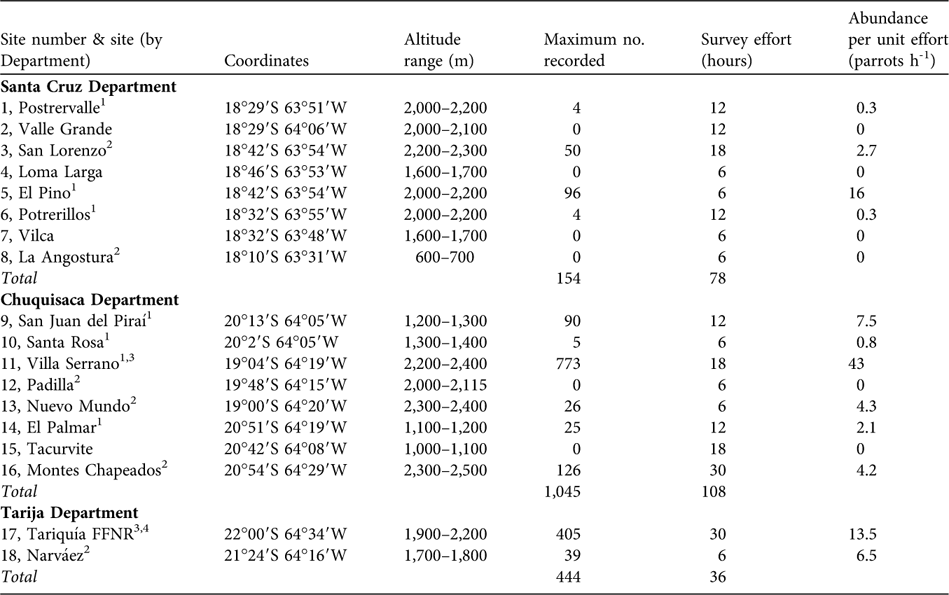The Tucumán parrot Amazona tucumana is restricted to the southern Yungas mountains, i.e. the strip of tropical and subtropical montane forest on the eastern slopes of the Andes, from south-eastern Bolivia to north-western Argentina (Fjeldså & Krabbe, Reference Fjeldså and Krabbe1990). The species formerly underwent intense capture for the pet trade, with 18,641 legally exported from Argentina during 1985–1989 (Nores & Yzurieta, Reference Nores and Yzurieta1994). In 1990 the species was included in CITES Appendix I, and thus its international trade was banned. Collar & Juniper (Reference Collar, Juniper, Beissinger and Snyder1992) included the species on their list of highly threatened parrot species because the reported levels of exports suggested a serious decline. Recently the status of the Argentinian population of Tucumán parrot was assessed (Rivera et al., Reference Rivera, Politi and Bucher2007) and the species categorized as Near Threatened on the IUCN Red List (BirdLife International, 2008). However, there is insufficient information on the status of the species in the Bolivian portion of its range.
The southern Yungas in Bolivia extends from the Santa Cruz Department through the Chuquisaca and Tarija Departments to the border with Argentina in the south, covering an area c. 530 km long and 70 km wide, and is considered a threatened ecoregion in Bolivia because of forest fragmentation and conversion (Ibisch & Mérida, Reference Ibisch and Mérida2003). Here we provide updated information on the status of the Bolivian population of the Tucumán parrot and assess past capture levels for the international pet trade. This information, together with data on the species in Argentina (Rivera et al., Reference Rivera, Politi and Bucher2007), provides the basis for a global assessment of the conservation status of the Tucumán parrot.
We conducted a complete literature review, and interviewed researchers, to determine the species’ distribution (Table 1) and sites to be surveyed. We surveyed 18 sites (Fig. 1, Table 2), from August to October 2006 and in September 2007, driving and walking along secondary roads, trails and river banks throughout the elevation gradient (Pitter & Christiansen, Reference Pitter and Christiansen1995) during the non-breeding season, when flocks are easier to detect. All individuals seen flying or perching were counted. At each site we searched for a minimum of 1 day, 3 hours after sunrise and 3 hours before sunset, at which times parrots are active and noisy and easier to detect (Pizo & Simao, Reference Pizo and Simao1997). When a roost was found we made point counts of unlimited time to estimate the number of parrots entering or leaving the roost. To avoid overestimation (i.e. double counting on successive days) or underestimation (averaging) we used the maximum number of parrots seen in each 3-hour period or at each roost as an estimator of numbers at each site. For each site we calculated abundance per unit effort, i.e. the total number of individuals recorded per survey hour.

Fig. 1 The southern Yungas in Bolivia (grey shading) and the sites surveyed for the Tucumán parrot Amazona tucumana in 2006 and 2007 (showing where the species was recorded in this and previous studies, sites where we did not recorded the species, and new records). Numbers correspond to the sites in Table 2 and large circles to the three areas that we propose as priority areas for conservation of the Tucumán parrot: Villa Serrano, Montes Chapeados and Tariquía Flora and Fauna National Reserve (TFFNR). The inset indicates the location of the main map in South America.
Table 1 Previously published records of the Tucumán parrot Amazona tucumana in Bolivia.

Table 2 Sites surveyed for the Tucumán parrot, by Department, in Bolivia (Fig. 1) in 2006 and 2007, with maximum number of Tucumán parrots recorded, survey effort and number recorded per unit effort.

1 New records for the species
2 Previously mentioned in the literature (Table 1)
3 Roosts
4 Tariquía Flora and Fauna National Reserve (FFNR) includes: Zalsamoral, Puesto Viejo and Campamento de los guardaparques (the Park ranger camp)
We conducted interviews with local people who were likely to have information about the parrot trade, checking that the person knew the species and could differentiate it from other parrot species. We discarded information that we considered doubtful.
From the literature we found 16 sighting records of the Tucumán parrot in Bolivia (Table 1). Grouping of some of the records resulted in 10 areas where the species was previously recorded. Three of these areas were inaccessible or could not be located (Table 1) and thus we surveyed seven areas, encountering the species in four. We also visited 12 areas with no previous records of the species and detected the species at seven (Table 2). We travelled c. 6,000 km by vehicle and walked c. 65 km, totalling 222 hours of observations, and recorded a total of 1,643 Tucumán parrots. Two areas harboured > 75% of the individuals detected (773 individuals in Villa Serrano and 405 in Tariquia Flora and Fauna National Reserve); both areas harboured roosts.
According to the 13 people interviewed c. 5,400 Tucumán parrots were captured legally for the international pet trade during 1981–1983 at roosts near the towns Valle Grande, Postrervalle, Potrerillos and San Lorenzo in the Santa Cruz Department. Our respondents indicated that since then the species has not recovered to former levels. Additional captures for the local market took place in Tariquía Flora and Fauna National Reserve and Narváez in Tarija Department, and Potrerillos in Santa Cruz Department. Our respondents indicated that the last captures took place in 2001, when 200 parrots were illegally mist netted in Potrerillos and sold in Santa Cruz city. In 2005 the illegal pet trade monitoring programme conducted by Asociación Armonía detected 42 individuals in captivity in Santa Cruz city (M. Herrera, pers. comm.).
Illegal capture of the Tucumán parrot for local trade appears to continue at a reduced scale. It is common to observe Tucumán parrots as pets in Bolivian towns. Captures occur even in protected areas, where chicks are extracted from nests, e.g. in Tariquía Flora and Fauna National Reserve at least 10 people capture parrots from approximately 50 nests annually, removing the entire brood of each nest. A similar situation has been observed in other areas of Tarija Department, such as in the town of Narváez (Tariquía Flora and Fauna National Reserve rangers, pers. comms).
The number of Tucumán parrots we recorded in Bolivia is c. 25% of the number recorded in Argentina (Rivera et al., Reference Rivera, Politi and Bucher2007), in agreement with other reports (Ridgely, Reference Ridgely and Pasquier1981; Juniper & Parr, Reference Juniper and Parr1998). Although the southern Yungas in Bolivia cover an area 20% smaller than in Argentina this probably does not entirely explain the difference in the population sizes.
Sixty percent of the Tucumán parrots we recorded in Bolivia were in previously unknown sites, and there are other areas that could potentially harbour the species and should be surveyed. The largest concentrations of Tucumán parrots in Bolivia are in Montes Chapeados, Villa Serrano, and Tariquía Flora and Fauna National Reserve; these areas are the largest fragments of suitable breeding habitat (i.e. mature Podocarpus–Alnus forest) and warrant high conservation priority. In southern Bolivia this forest only occurs in a narrow zone and is threatened by lack of regeneration because of burning to sustain extensive cattle grazing. This forest type is restricted to areas where fires normally do not enter (Fjeldså & Mayer, Reference Fjeldså and Mayer1996).
The designation of Serranía del Iñao (near Villa Serrano) as a National Park and Sustainable Management area in 2006 may provide a legal framework to undertake conservation actions for the Tucumán parrot, especially considering that the largest roost (Villa Serrano; Table 2) is near this protected area. In Tariquía Flora and Fauna National Reserve there is a need to develop conservation strategies to halt the unsustainable use of forest resources (Kessler & Beck, Reference Kessler, Beck, Kappelle and Brown2001). Because of its inaccessibility, Montes Chapeados is relatively undisturbed and has the largest area of suitable breeding habitat. The largest population (at least 900 in one roost) of Tucumán parrot in Bolivia was recorded by Fjeldså & Mayer (Reference Fjeldså and Mayer1996) in Montes Chapeados; we found only 126 there, possibly because we did not survey at the same time of the year or because we did not find the roost.
In total we have recorded a total of 7,650 individuals of Tucumán parrots in Argentina (Rivera et al., Reference Rivera, Politi and Bucher2007) and Bolivia. It is likely that the present population size is lower than before 1980, when captures of Tucumán parrots for the international pet trade reached an estimated peak of 20,000 from Argentina (Nores & Yzurieta, Reference Nores and Yzurieta1994) and 5,500 from Bolivia. The present total population is only a third of the birds removed during the 1980s, and most probably could not sustain that level of capture.
In Bolivia the critical factors threatening the Tucumán parrot include habitat loss and the illegal pet trade. Forests are affected by industrial timber extraction, widespread slash-and-burn agriculture (chaqueo), even in protected areas, and wildfires in mature Podocarpus–Alnus forests. In Argentina, forest loss and degradation are the most critical factors affecting the southern Yungas (Pacheco & Brown, Reference Pacheco and Brown2006).
The available evidence indicates that the Tucumán parrot meets criterion (IUCN, 2001) A2 (i.e. an inferred or suspected ≥ 30% population reduction in the last three generations determined through a decline in habitat quality and real levels of captures) for categorization as Vulnerable on the IUCN Red List (IUCN, 2009).
Acknowledgements
This work was supported by Loro Parque Fundación. We are grateful to Pedro Blendinger, Oswaldo Maellard, Paola Montenegro and Sebastian Herzog for information. Jorgelina Brasca revised the English text. LR conducted this work as a Doctoral student of the University of Córdoba, Argentina, with the support of Fundación YPF and Overbrook Fellowship.
Biographical sketches
Luis Rivera is President of the Foundation for Conservation and Study of Biodiversity. He has been leading projects on parrot conservation since 2000, including on the reproductive biology and ecology of the Tucumán parrot, and is developing a regional conservation strategy for the species in north-west Argentina. Raul Rojas Llanos is coordinator of the Tucumán project in Bolivia and has extensive experience studying the wild parrots there. Natalia Politi is using the habitat requirements of cavity nesting birds to guide timber management. Bennett Hennessey manages the BirdLife South American Preventing Extinctions programme and is the Executive Director of Asociación Armonía in Bolivia. Enrique Bucher conducts research on parrots in Argentina and on the management of natural resources in Latin America.







